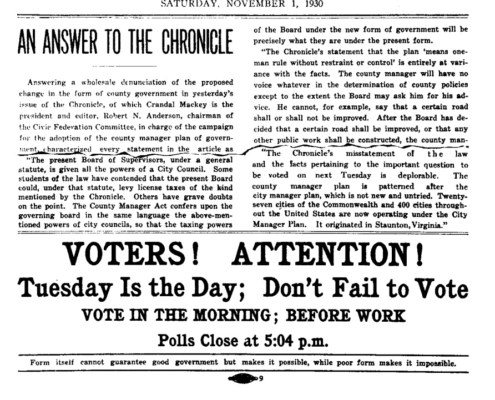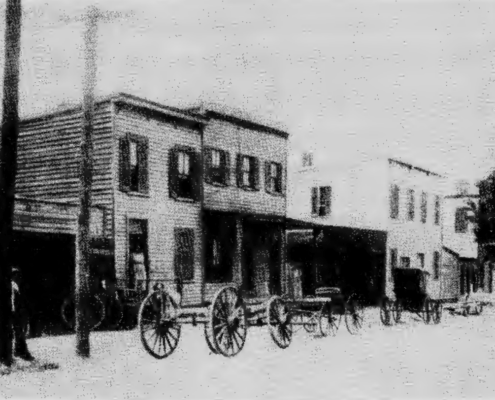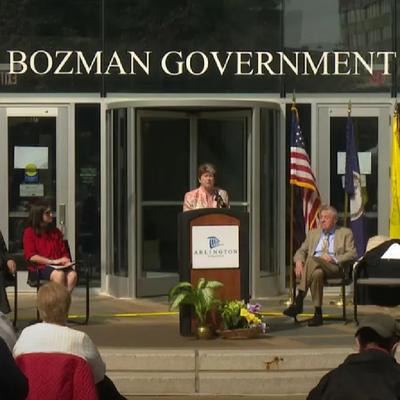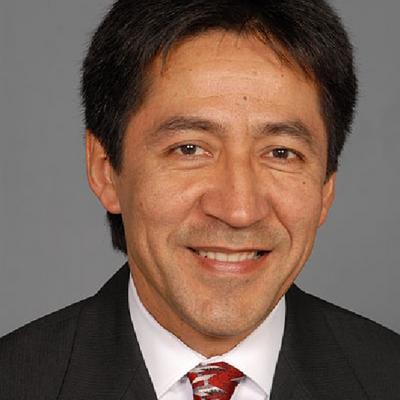
Arlinglon Adopts the County Manager Form of Government
It became increasingly clear that the form of government originally prescribed by the Virginia Constitution of 1902 was not meeting the needs of those counties which were gradually becoming more urbanized. In its original form, the 1902 Constitution set up a rigid system of county organization and government, and the General Assembly was powerless to comply with the demands of the leaders of Arlington for an improved system.

Judge William T. Newman, Jr.
In 1987, he was elected to the Arlington County Board, becoming the first African American elected to the board since Reconstruction.

Arlington’s Path to Self-Government
Arlington’s story of local government is one of transformation, from scattered rural communities to one of the most interesting counties in Virginia. A century ago, Arlington was still defining what it meant to govern itself.

Bennett v. Garrett
In 1920, members of the Clarendon Citizens’ Association petitioned to incorporate as the Town of Clarendon. Supporters argued that a local government could more effectively provide water, sewers, police, and fire protection. At the time, Arlington had only one sheriff, limited infrastructure, and relied on citizen groups to fill the gaps.

Arlington’s First Openly LGBTQ Elected Official
In 1997, Jay Fisette became the first openly LGBTQ+ person elected to office in Virginia when he won the Arlington County Board seat. Fisette served for six terms on the Board, from 1998 to 2017, and served as Board Chair five times, including in his final year.

The Organized Women Voters of Arlington
A decidedly non-partisan organization, the OWV was unique in its distinct attention to matters facing the County. In an interview with the Northern Virginia Sun in 1958, then-president Ms. Woolley stated she believed “that the Organized Women Voters of Arlington is the only women voters’ group in the United States concerned solely with matters of local interest.”

Ellen Bozman
In 1973, Ellen Bozman ran for the Arlington County Board under the slogan, “Let’s keep Arlington a good place to live…and make it better.”
During her tenure from 1974 to 1997 as the longest-serving county board member to date, Bozman’s dedicated service and ingenuity fulfilled this goal. Her foresight and leadership guided Arlington as it transitioned from a suburban enclave to a bustling urban community, as she advocated for controlled development, instituting services for older people and children, and open government.

The Story of Smart Growth and the Metro
In the mid-1960s, the Washington Metropolitan Area Transit Authority (WMATA) proposed a rapid rail system with two lines in Arlington County: one line following I-66 to Fairfax and another servicing the Pentagon, National Airport, and Crystal City. Arlington County officials, however, successfully lobbied for the proposed I-66 line to follow Wilson Boulevard and Fairfax Drive instead (the former route of the WA&FC trolley line) to stimulate development along the aging corridors. Many of Arlington’s Metro Stations, including Ballston and Virginia Square, opened in 1979, transforming the community from small shops and businesses into a thriving urban village.

J. Walter Tejada
In 2003, J. Walter Tejada became the first person of Latin American heritage to be elected to the Arlington County Board or any governing body in Northern Virginia. Tejada served as County Board Chair in 2008 and 2013.

The Arlington Way
The term "Arlington Way" is commonly used to describe the county's non-partisan, cooperative political culture. Its history is rooted in the 1930s and 1940s, when Arlington's local politics shifted away from partisan battles to a non-partisan system, fostering a collaborative and consensus-driven approach to governance that continues today.
